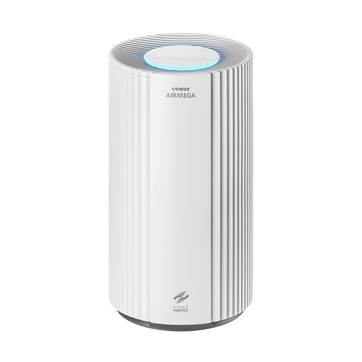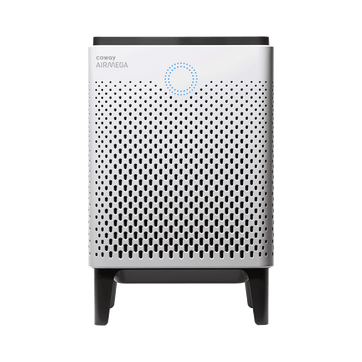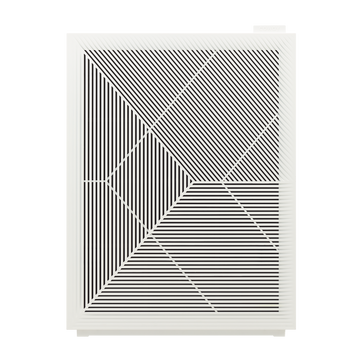
How Do Air Purifiers Impact Pets?
You’d do anything for your pets. The cat hair in the deepest crevices of your keyboard and the cupboard full of organic, fair-trade dog food prove it. You make sure your pets eat well, play well and live well. But are you making sure they breathe clean air along the way?
We see you out there with your puppy pilates classes and impromptu midnight visits to the animal clinic. We know you put the work in for your best little furry friend’s well-being. Now it’s time to make sure the air they breathe is contributing to their long, healthy, and active life. They’ll thank you for it later–with big slobbery kisses.
Are Air Purifiers Safe for Pets?
Air filtration devices like those in Coway’s lineup are sealed and stable, so they won’t pose any mechanical or electrical risk to your family’s pets, so long as the wires are secured from pets who like to chew.
But air purifiers aren’t just safe for pets to hang out around. The air they purify is totally safe – and genuinely beneficial – for pets to breathe. Since air purifiers filter pollutants and irritants from indoor environments, they can help reduce short-term irritation and ease long-term health conditions in pets, just as they can in people.
While masking up can help people filter air personally, organizations like Guide Dogs for the Blind don’t recommend masks as a safe air quality solution for dogs. On the other hand, air purifiers can help your pets breathe clean air in just the same ways they help humans breathe clean air. Just make sure you keep them in a tip-safe spot.
How Air Purifiers Benefit Your Pets
Now that you know air purifiers are safe for pets, what can they actually do for your fur baby’s well-being? As Bond Vet Clinic's primary care director, Dr. Gabrielle Fadl, tells CNN Health, “Exposure to polluted air can have a profound impact on our pets’ health.”
Air purifiers help remove a significant amount of those pollutants from the air, with filters ensuring that your pets breathe clean air indoors. Speaking to Vox, veterinarian Lisa Lippman says, “A lot of people don’t realize that animals can experience things almost exactly in the same ways that we do. They have the same organ systems that we do, and they’re really, really susceptible, especially [to air pollution] if they’re in at-risk categories.” Purification systems reduce everything from the fine particulate matter of wildfires and car exhausts to the presence of airborne viruses in our air supply, and our pets benefit from this in ways similar to their owners, such as:
Respiratory Health
According to the Minnesota Pollution Control Agency, studies have shown that dogs exposed to heavy air pollution suffer increased inflammation while cats exposed to passive indoor smoke have reduced lung functioning, for example. And as climate change leads to more wildfires every summer, air filters can help reduce dangerous pollutants like hydrogen cyanide and carbon monoxide in our pets’ air supply on smoky days.
Long story short, animals experience difficulty breathing and respiratory issues from asthma to bronchitis for the same reasons that we do, and the improved air quality offered by air purification systems can help reduce these issues.
Allergy Relief
When it comes to allergies, pets can suffer from irritation, inflammation, difficulty breathing and (adorable) sneezes, too. In fact, just as is the case with respiratory issues, pets can be even more susceptible to this air quality issue due to their small size. To cut back on the airborne particles that trigger allergic reactions, the American College of Allergy, Asthma & Immunology recommends air purifiers equipped with high-efficiency particulate air (HEPA) filters, which all Coway air care devices use. With the Coway Airmega, for example, smart HEPA filters are specifically to clean your indoor environment, reducing harmful particulates and unpleasant odors.
Fewer Chemicals and VOCs
Pets’ smaller size can also make them more vulnerable to airborne chemical pollutants such as VOCs, or volatile organic compounds, which can be left behind by everything from cleaning products to synthetic fabrics. Animal Wellness Magazine notes that chemical irritants in VOCs can lead to dizziness, nausea, fatigue and ear, nose and throat irritation in pets. Those same airborne VOCs can be significantly reduced with activated carbon filters (and, yes, we use those, too).
Clean Air For All Members of Your Household
Sure, air purifiers can directly impact your pet’s well-being, but they pack some bonus benefits for pet parents, too. Alongside all of those respiratory benefits we covered earlier, air purifiers help cut back on pet fur and dander in indoor spaces, which can in turn cut back on allergy symptoms. Our HEPA-equipped purification systems can collectively filter air particulate up to 99.99 percent, which translates to way less pet-produced allergens floating around.
And let’s be real. As cute as your pets look, they almost never smell cute. A 2020 study in Veterinary Medicine and Science declared that “Poor indoor air quality may exacerbate airway disease in pets and should not be ignored.” And neither should that wet dog smell, to be honest.
Dan is a Dallas-based freelance writer and consultant specializing in tech, media analysis and lifestyle content. In his decade-plus experience, he's been fortunate enough to work alongside partners including Samsung, BRIO, ASUS, Verizon, Sony and many more.
Sources
Live Science - Are Air Purifiers Safe for Pets?
CNN Health - Wildfire Smoke Is Bad for Pets, Too. Here’s How to Keep Them Safe
Minnesota Pollution Control Agency - Air Quality Alerts: Your Questions Answered
Guide Dogs for the Blind - Dogs and Poor Air Quality
Vox - If You Can’t Breathe Well, Neither Can Your Pet
National Library of Medicine - PMC PubMed Central: Veterinary Medicine and Science: An Observational Study on the Role of Indoor Air Pollution in Pets with Naturally Acquired Bronchial/Lung Disease
American College of Allergy, Asthma & Immunology - Air Filters
Animal Wellness Magazine - Protecting Your Pet from Indoor Air Pollution
Disclaimers
1Coway air purifiers has been proven to trap dust, pollen, dander, viruses and bacteria in the air based on KCL (Korea Conformity Laboratories) testing.They have been tested in a 30㎥ size chamber according to the Korea Air Cleaning Association standard (SPS-KACA 002-132:2022 Modified) to measure the 0.01㎛ size of particle removal rate. It was tested on maximum airflow speed in normal room temperature and humidity conditions. The performance may vary in the actual living environment of customers.
→ Tested with Airmega Aim, 150, 160, AP-1216L, AP-1512HH, AP-1512HHS, 200M, Icon, IconS, 230, 240, 250, 250 Art, 250S, 300, 300S, 400, 400S, ProX
299.97% of viruses, bacteria, fungi and pollen were verified to be removed from the air for Coway air purifiers which have Green True HEPA™ filter applied based on the Japan Food Research Laboratories(JFRL) testing according to JEM 1467 standard.
→ Tested with Coway Airmega AP-1512HH, AP-1512HHS, 250, 250 Art, 250S, 300, 300S, 400, 400S
→ All tested by JFRL and received above result within below time.
All tested by JFRL and received above result within below time.
- Virus: Tested with Escherichia coli phage ΦX174 NBRC 103405, 60 minutes
- Bacteria: Tested with Staphylococcus epidermidis NBRC 12993, 60 minutes
- Fungi/Mold: Tested with Penicillium citrinum NBRC 6352, 60 minutes
- Pollen: Tested with Cedar Pollen extract, 60 minutes
3Aerosol test conducted in a Biosafety level 3 laboratory with two Coway air purifier models, Coway Airmega 250 and 400 for removal of SARS-CoV-2 Aerosol by US based MRI Global, a not-for-profit laboratory and partner of US Department of Defense. The test was conducted in a 13.1ft3 chamber. Virus was aerosolized for 15 minutes and the product was turned on high for 2 minutes. Result showed each product effectively removed over 99.98% of the SARS-CoV-2 in 2 minutes. This is a result from a laboratory experiment condition and result may vary in different conditions. This result does not imply it kills SARS-CoV-2 or prevents the transmission of Covid-19. Coway Airmega 250S and 400S are identical to the tested models and has equal performance with an additional mobile connectivity function.
4The concentration of ammonia, acetaldehyde and acetic acid were proven to be removed within 30 minutes by FCG Research Institute, Inc. Human Life Science Lab. It is not a demonstration result in the actual use space. Not all odors and gases may be supported. → Tested with Coway Airmega 150, 160, AP-1512HH, AP-1512HHS, 400, 400S
5The coverage area of the air purifier is based on an area where the air cleaner can make two air changes per hour (ACPH). An air change per hour translates to how many times an air purifier can clean an area, assuming the height of a ceiling to be 8 ft, in one hour. Therefore ** means two air changes per hour means that the cleaner can clean the area once every 30 minutes and * means air changes per hour means that the air purifier can clean the area once every 60 minutes.
10Terms and conditions apply. Discounts, including promotions, coupons, bundle discount and subscription discount, cannot be stacked on top of other coupons. During promotional periods, discount codes will not be able to be applied to orders. Promo codes may apply to products only—filters, accessories, and new products within 3 months of the release date are not included.




















